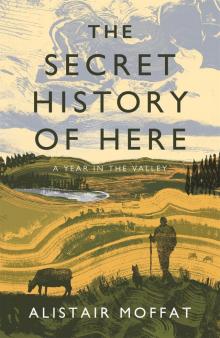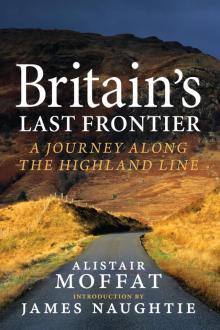- Home
- Alistair Moffat
The Secret History of Here Page 28
The Secret History of Here Read online
Page 28
These clay deposits were at the core of Home Douglas’s thinking. Dense, extensive and of very high quality, the clay beds could be scraped (which is why the Tile Field is billiard-table flat) and moulded into tiles and the ceramic drainage pipes that were needed to improve the land. The auld stane drains of the sort I broke into when my son’s house was being built were very labour intensive and took a long time to complete. Clay pipes fired in a kiln could be laid much more quickly. The pleasing symmetry of Home Douglas’s scheme was that all of the materials he needed were close at hand. Running on either side of the clay of the Tile Field were the Common Burn and the Hartwood Burn, ready sources of clean water for puddling the clay. A pond was formed that still survives but is now home to a pair of swans. And on the south side of the old Roman road a vast plantation had grown up on the slopes of the ridge, imaginatively known as the Big Wood. Its timber would fire the kilns needed to bake the tiles and the drainage pipes.
On yet another dripping autumn morning, I pumped up a slow puncture in a rear wheel, started my quad bike and drove off down the Long Track to see what remained of the Commander’s enterprise. And the immediate answer was almost nothing, not even humps and bumps in the grass of a park where cattle were grazing. No trace could be seen of the extensive wooden buildings of the Tile Works. All I could find was the shattered debris of fired orange pipes by the gate between the two parks. And yet at least one family and possibly more people had lived there, next to this busy manufactory.
With the growth of local newspapers, and after the first census of 1841, the lives of ordinary people at last come into focus. On 31 March 1859 at the Haining Tile Works, the death of Mary Donaldson was reported. She was the wife of Alexander Wilkinson, the overseer. He wasted little time as a widower and was married to Isabella, the daughter of James Riddell, a sawmiller. On 30 January 1862, she gave birth to a son.
The baby’s grandfather was a pivotal figure in this industrial story. James Riddell worked at a sawmill in the Big Wood and it supplied the timber and sawdust needed to fire Wilkinson’s kilns. Both sets of buildings appear on the first edition of the Ordnance Survey that was published after 1843. The Tile Works is shown as a series of long wooden sheds where tiles dried as they were moulded or cooled after firing. There is a dwelling house with a small garden plot to the north-east, where the Wilkinson family lived. Over in the Big Wood, about four hundred yards to the south-east, the sawmill is clearly marked next to the Hartwood Burn, as it rushed downhill from the southern ridge.
When I rode my quad bike up the path that led towards its site, I found that under the willowherb and dense grass it had once been an old-fashioned metalled road like the Long Track, but not torn to pieces by the big tyres of gigantic tractors. And there it was. Completely hidden by the stands of birches and willows by the rushing burn, a rotting old wooden shed stood, filled with rubbish. It was so close to the bank of the burn that it might have housed the water-wheel that powered the belts that drove the circular saws. Uphill, the Ordnance Survey plotted three gathering ponds that helped keep the flow strong even in the dry summer months. After days of rain, the Hartwood Burn was rushing downhill at a great lick. Despite thrashing through low and wet branches, I could find no traces of the old ponds.
What I did find in my warm and dry office was a group of three photographs online. They were taken between 1914 and 1918 and two show eight men who worked at the sawmill. Two are clearly the owner or manager and the foreman. They wear ties and suits and one of them sports fancy, shiny riding boots. Perhaps he had ridden to the mill to have his picture taken. As part of the posed composition, two of the men hold very large circular saws with large, jagged teeth, and behind them are tall stacks of what might be railway sleepers. The other photograph shows a version of a small railway running across a wooden bridge over the burn. A low bogie carries a load of uncut logs.
The sawmill was still in part-time use in the 1960s, but by 1897 maps show only the dwelling house still standing at the Tile Works. It too was probably a wooden building since there are no traces of any foundations left in the grass. Pringle Home Douglas’s factory and the sawmill are a pleasing example of local manufacture that accessed all of its material, energy and manpower within a radius of less than half a mile, something that should make a welcome comeback. On the wall outside the north door of our farmhouse sits a huge clay brick that was fired at the Tile Works. It is the size of a thick telephone directory, and beside it sits a length of orange drainage pipe and a blackened mass of others that were fused together in a kiln that was allowed to become too hot. Even though I never saw it, I mourn the smoke that no longer belches out of the Tile Works’ chimneys. It was a sign that the land was alive, working, producing.
8 October
This morning a young kestrel flew against the southern wind, hovering over the grass parks by the Long Track before soaring. I watched it bank against the breeze, fluttering and wheeling before it flew into the blinding eye of the sun and disappeared.
Angus came to cut the grass for the last time this year. Another summer has passed but the smell of cut grass lingers around the farmhouse long enough to console me. I wondered where our swallows were. Over the Sahara now, I should think, the most testing stage of their long journey to southern Africa.
9 October
I checked on the Old Boys and the retired brood mares this morning, and they all looked well after a summer of lush, rain-fed grazing. Their gleaming condition will help get them through the winter, but Gem is now very old at thirty-one. Half Dales Pony, he is hardy like most native breeds, and despite the ticking of the clock I suspect he will still be with us next spring. The mares were lying down, their bellies the highest point, little dark bay hills.
11 October
I like my day to begin in darkness, to be up and doing before dawn, switching on lights, lighting the fire, making tea and then getting outside with the dogs so that we can all sniff the weather. The morning stars glittered in the southern sky and Orion planted his feet over the Big Wood. I imagine him standing foursquare, his hands on his hips just above his sword-belt, glowering down at us. When the pale blue glow from the east began to rise, the stars faded in moments, and by the time Maidie and I were out in the Deer Park, checking on the mares and the Old Boys, the sun was warming a glorious morning.
12 October
The colours of Scotland glowed in the sunshine. A morning wind had freshened off the western hills and, like drawing curtains, had cleared away the early clouds to let the sun splash over the farm. Blood-red berries fat with juice hung on the geans beside the old gold of their yellowing leaves. Two dense and glossy hollies mark the turn of the Top Track and, from the corner, I could see that the Corstorphine sycamore on the fringe of a far grass park had turned bright yellow. Each spring it is the first to flush with green leaves and the first to turn yellow at the end of summer. The tiny leaves of the avenue of alders by the old Roman road were flittering in the breeze of a fresh, clean, cold autumn morning.
13 October
On the night of 6 June 1841, every household in Britain was counting. Spread on the kitchen table in front of the Head of the House was a form and, with pen or pencil poised, he (almost always a he) began to write down the names, ages and professions of everyone who would sleep in the house on that summer night. A year before, parliament had enacted the Population Bill and it set out a new and comprehensive code for conducting a census every ten years. Up until that time, the pattern of calculation had been patchy since each parish did not record their numbers at the same time. There had been a high degree of double-counting and omission.
An enumerator was appointed for each census district and he had to be able to deliver all of the necessary forms and, most important, subsequently collect them all in one day, 7 June. Selkirk Parish was too large and dispersed even for an enumerator who had a horse and it seems to have been divided into eight or nine smaller districts.
Sometime in the week before 6 June, the enum
erator had ridden up the Long Track, tied up his horse, taken a form from his satchel and knocked on the door of the Henhouse, moving under the ornate, semi-circular porch on its wooden columns and between the sculpture niches. It was opened not by one of a group of young ladies from Edinburgh but by the sole occupant, Anne Moscript. When she sat down at the kitchen table on the evening of the Sabbath Sunday 6 June, a date deliberately chosen when no one would be at work, Anne recorded that she was fifty-five years of age and that she was employed as a farm servant.
Almost certainly working on the Haining estate, she was probably a bondager. So-called because of the bond or contract she had agreed with the farmer or estate manager, her work was hard and unrelenting. Wearing their characteristic wide-brimmed bonnets, bodices and long, full skirts, bondagers were field workers who planted and hoed the weeds from between dreels of root crops like turnips or potatoes. They helped with the hay-making and the harvest. Around the steading, they milked cows, made butter and cheese, and looked after the hens. Bondagers did all of the manual work that did not involve horses. That was the preserve of men: ploughmen, harrowers, reapers and carters.
At fifty-five Anne was getting on for a bondager, having spent more than forty years working hard and out in all weathers, our clayish soil clinging to her boots on wet days. Her solitary life in the Henhouse suggests that it had only recently become a more respectable address. Perhaps Anne was evicted occasionally in the summer when there was a ball at the big house, an arrangement that was much simpler than moving out a family and moving the young ladies in. Moscript is an unusual name, but nineteenth-century records show several families of Moscripts living in Teviotdale. Anne may have been buried in the cemetery at Morebattle; I have not been able to find her headstone.
When we bought the half-ruined cottage in 1991, I remember the kitchen well, the place where Anne probably sat with the census form in the summer of 1841. It was a small, snug room with a long, black, wrought-iron range along the internal wall and a wide window on the eastern side to welcome the morning sun. Under the chimney we still use was the partly open fire grate that heated the ovens on either side. I still have it and the iron swee. It was a swinging arm from which a kettle could be suspended over the fire. It could be moved away from the heat so that a pot could be substituted. On the evening of 6 June there was probably evening light by the window for Anne to see what she was doing. When she noted down her age and profession, she added that she had not been born in Selkirk Parish.
Across at Hartwoodburn Farm, there were problems with spelling. In the farmhouse and the cottages by the old Roman road, twenty-four people lived and some of this community of farm workers seem to have had their names recorded phonetically. At eighty, Isble Cavers was a very old lady, a matriarch who had lived through both the American and French Revolutions, but her given name was surely Isabel or Isobel. Opposite Isble’s name is an intriguing entry that may indicate another sort of matriarchy. Where others have their occupation listed, she was indep. That signified a person of independent means who did not have to work. There is no distinction made between the farmhouse and the cottages, but it is likely that Isble Cavers lived in the largest house with George and Elizebeth (sic) Riddell.
Amilia Miller and Lillies Laidlaw need only a little correction but what is to be made of Chaterane Miller, Amilia’s mother? Perhaps Catherine? The entry of Nices son opposite a five-year-old William Innis (sic) probably tells a tale of the times. He lived in the same cottage as his uncle William Laidlaw and his aunt Lillies and may well have been an illegitimate child. To lessen the stigma for the mother, little ones born out of wedlock were often sent away to be raised by relatives.
Across the flat Tile Field from Anne Moscript’s solitary life in the Henhouse, Hartwoodburn was a busy community. Seven children under ten ran around the steading and the inbye fields, shrieking, shooing hens, looking for eggs amongst the ricks of the stackyard, helping bring in the milker cows in the evening, chasing rats, playing with the collies and the farm cats. Almost two centuries later, there are no children, no one living at Hartwoodburn who works on the farm. My neighbour and his colleague run both it and Middlestead at the same time, their carts and tractors often trundling along the old road between the farms.
Annie Moffat, my great-grandmother, was a bondager, and while it might have been an outdoor, even wholesome life, it was hard. I have a photograph of Annie on my desk that was taken after the Great War, when she was about the same age as Anne Moscript. The wind and rain of forty winters are etched on her lined face and her stoic, unsmiling expression, her jaw habitually set against the elements.
I write this on a damp, rainswept day with some farm chores to do before I can sit down in front of the woodburner with a glass of something warming. When Anne came back to the same front door, she will have scraped her boots and brushed the cloying mud off her skirts. In the narrow hall, her coat came off and, with her boots, was set in front of the range to dry off. And a cup of hot, maybe sweet tea grasped with both hands will have taken the edge off the cold. We have at least kept her fire burning, and not forgotten her.
14 October
A full moon sets in the west, a mist veils the Tile Field and the first hard frost of the early winter crackles underfoot. When she opened the same door, Anne Moscript saw the same sky, the same moon and stars. Having riddled the embers in the grate and set some big logs on the waking fire, she will have shivered in the unheated little cottage. Pulling on a dry coat, Anne was in the habit of going out to the old looseboxes to fill her log basket. Only when the fire in the range blazed could she make tea and perhaps some warming porridge.
Like almost all farm servants in the nineteenth century, bondagers worked for a fixed fee, cash that was paid at the end of a six-month or annual term. As important were payments in kind, what were known as gains. As part of the bargain, the farmer was bound to provide not only a cottage but also the likes of oatmeal, dreels of potatoes to be dug when needed, perhaps grazing for a cow, keep for a pig and, crucially, a supply of logs or coal, the latter much preferred. At the beginning of each term of employment, a cart would come bumping down the track and simply dump Anne’s supply near the cottage door.
In the nineteenth century, coal mining was not far from the Scottish Borders. At Scremerston near Berwick-upon-Tweed and Shilbottle near Alnwick, pits supplied domestic coal. When a horse-drawn coal cart came down our street in the 1950s, it carried Shilbottle coal, its prices chalked on a slate attached to the backboard. The colliery belonged to the Co-op and costs were consequently kept down. Alarming men with black hands and faces who wore studded leather back protectors unloaded sacks of shiny black coal and shook them into our bunker at the back of the house. My gran bought big pieces of darkly lustrous cob coal we broke up with the blunt end of an axe. She also handed over a few pennies for a bag of what she called nutty slack. It was very cheap but heavy – coal dust mixed with small nuts of solid coal – and it was used to smoor a fire overnight. With the damper closed, the embers glowed, slowly burning under a thick blanket of slack, keeping the temperature above freezing. When she left her cottage to walk the Long Track to the Haining, Anne Moscript will have done the best she could manage with logs to keep her fire smouldering all day.
This morning the autumn air had a woody scent, like pencil shavings. Although I get up in the dark, like Anne, I wait for the dawn light before going out. Carrying her piece, some oatcake or bannock and perhaps some cheese for her dinner (lunch was for the quality, dinner at midday for the workers), she walked the Long Track to the big house to get her orders for the day from the estate manager or overseer. Perhaps she mucked out the stables in the morning after the Clydesdales had been led out to the fields, perhaps she helped lift late potatoes to store them in an earth and straw clamp, perhaps she helped with the morning milking or butter-and cheese-making. At fifty-five, after a lifetime in the fields, Anne’s body will have creaked a little as she picked up a graip or a shovel and an indoor job will
have been welcome.
In the winter months, home before dark, the fire brought to flaming life, Anne made and ate a solitary supper in the warm kitchen. She probably slept there in a box bed, and in the summer months may have moved to one of the upstairs bedrooms where it was cooler. For entertainment, Anne probably read. One of the very few fragments I have of the life of my great-grandmother Annie Moffat is that she always had a book on the go. My sister Barbara has inherited this habit, as well as Anne for her middle name. Our great-grandmother may have been a member of a subscription library in Kelso (where there were three) and so it could not have been expensive. There was also one in Selkirk, and perhaps Anne Moscript joined it. Unlike now, newspapers were not immediately discarded but passed from hand to hand and read from cover to cover. Right up until the end of her life, my grannie read every page of the Scotsman, including the advertisements, and especially the obituaries. But candles and paraffin for tilly lamps cost money. Winter was the season for long sleeps and, after she had smoored the fire in the grate once more, Anne went to bed early.
15 October
‘Onwards and downwards!’ emailed Rory Low, with news of many more coin and metal finds along the length of the Long Track and in the field around the shadow of what might be an Anglian village. He always sends photographs of the many silver pennies, and the doll-like faces of ancient kings stare at me from the screen of my laptop. Around the rims of the pennies are stamped their names and on the obverse there is almost always a cross. Secular and spiritual power preserved on a thin sliver of silver often no larger than a thumbnail.
Rory’s expertise is to be marvelled at. He can tell where and often exactly when the coins were minted and one of the coins that came up last weekend was exotic, a penny from the mint of Guy de Dampierre, Count of Flanders and Marquis of Namur. Long before the euro was ever thought of, there was a currency that crossed the Channel. Rory has found several coins from the reign of Henry III that were freshly minted, prompting a perceptive observation from Walter. To prosecute his long Scottish wars, Henry’s son, Edward I, was clearly emptying the royal treasury. Rory’s find and Walter’s reading of the land are like small pieces of an unmade jigsaw whose picture is gradually forming.

 The Secret History of Here
The Secret History of Here The Night Before Morning
The Night Before Morning To the Island of Tides
To the Island of Tides Arthur and the Lost Kingdoms
Arthur and the Lost Kingdoms Britain’s Last Frontier
Britain’s Last Frontier The Faded Map: The Lost Kingdoms of Scotland
The Faded Map: The Lost Kingdoms of Scotland The Wall
The Wall